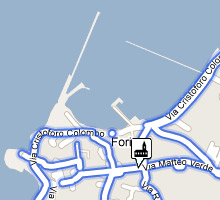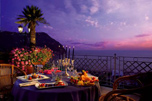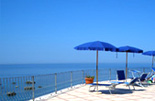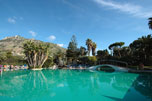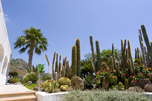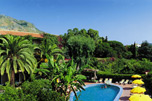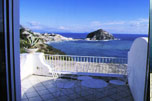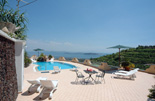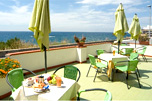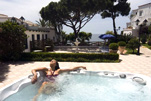Description
The Church has an imposing facade, elevated above the street level, accessible through the stands and is flanked by two bell-shaped pear. The building has a Latin cross with three naves, divided into four bays. The roof of the nave is painted and gilded coffered and the center has a painting on canvas. The apse is octagonal vaulted roof and some windows in the lunettes guitar-shaped, were widely used in the Baroque period. The hemispherical dome covers the junction with the transept. The material with which it was built of tufa stone painted plaster.Historical Info
The church was founded in the fourteenth century by sailors (as reported by the news of D’Ascia, not confirmed by other sources, some fishermen of Ancona, who introduced the cult of Our Lady of Loreto) as a small oratory dedicated to S. Nicholas of Tolentino. From the ancient Gothic building is not much left. Salvati suggests that the original church was made up of a single environment, which corresponds to the central nave, covered roof and lancet windows. The construction of the church gave start to the development of the town of Forio from the hilly area of the church of S. Vito south of the pier area. Since the end of the sixteenth century the building underwent a series of interventions and expansions that transformed the original chapel in a church of considerable size. They were presumably made the two aisles, the transept and the dome; documents preserved in the church for demonstrating several payments in the years 1578-87 those master Pietro Verde e Jo. Minico Pepe for the construction of the apse (Delizia, 1897, p. 214). Between 1581-82 it reached to the definition of the structure. Further additions resulted in the creation of a true multi-functional complex that includes, besides the church, a chapel and a hospital. In 1585 was built on the right side of the church, a chapel dedicated to the Assumption of worship to meet the needs of the members of the congregation and some years later, at the left of the nave, were built some rooms, which were already in a hospital operating since 1596. The building thus became a key reference point for the local community, both for its facilities and services offered by the social role of a gathering and meeting place of Parliaments held by the public square. The complex was maintained with the help of fishermen who devote a portion of proceeds from the fishing needs of the church, hospital and brotherhood, as evidenced by the bull of Gregory XIV in 1590. The importance of the church is also confirmed by the frequent references in public documents and large sums for the University to subsequent extensions and enrichments that gave the complex a Baroque style. In the Baroque period was forwarded demolished the apse and transept, behind built another one already made. In the early eighteenth century the building was extended and a second dome was added and the choir, was designed around 1710 by his father between the Cherubim of Aversa altar, marble-run then by Gaetano Sacco. In 1731 the tower was built with the clock (later moved to Panza) at the expense of the University and in 1755 was erected the altar with colored marbles and then between 1780 and 1785 was covered with marble panels, the entire temple. In 1779 the Neapolitans Luca Scrimitone Moschetti and Eugene began the stucco work. Following the earthquake of 1883, the dome of the nave was replaced by a coffered ceiling. On July 29, 1787 he obtained a decree of the Coronation of Our Lady of Loreto.Inside the church we find: a panel of the Madonna of Loreto dated back to the XVI century by painter Decio Tramontano, two tables of Caesar Calise, one showing the "Martyrdom of St. Bartholomew "(1596) and the other represents S. Nicholas of Tolentino "(1607). Works by Alfonso Di Spigna “ The Rest on the Flight into Egypt” “Adoration of the Nativity”, “The Nativity” “ Lady” “St. Restituta” “S. Lamb”. Laudello Aniello with “Madonna and Saints” with the depiction of the "mysteries of the Rosary" (1581). Painting by Giuseppe Capuano with "SS. Trinity S. Sylvester Pope and S. Vincenzo Ferreri "(1777). Wooden crucifix Di Falco (1761).
objet d'art
Frescoes
- Madonna del Rosario by Di Laudello Aniello
- Madonna di Loreto e santi author unknown
- S. Nicola da Tolentino e Storie del Santo by Calise Cesare
- Madonna con i SS. Pietro e Paolo author unknown
- Madonna con Bambino e Santi author unknown
- Madonna con Bambino e Santi-2 author unknown
Toiles
- Presentazione al tempio della Vergine by Di Spigna Alfonso
- Assunzione della Vergine author unknown
- Gloria della Trinità con i SS. Gregorio Magno e Vincenzo Ferrer by Giuseppe Capuano
- Riposo dalla fuga in Egitto by Di Spigna Alfonso
- Nascita della Vergine by Di Spigna Alfonso
- Martirio di S. Bartolomeo by Calise Cesare
- Madonna di Loreto by Tramontano Decio
- Madonna con Santi by Di Spigna Alfonso
- S. Pietro e S. Paolo author unknown
- Visione di S. Giovanni Evangelista by Calise Cesare
- Annunciazione by Di Spigna Alfonso
- Transito di S. Margherita da Cortona author unknown
- Storie della vita della Vergine by Di Spigna Alfonso
- Madonna del Rosario-2 author unknown
- La Pentecoste author unknown
- Visione di S. Giovan Giuseppe author unknown
- S. Giuseppe col Bambino e Estasi di S. Antonio da Padova attr. all' Sarnelli Antonio
sculture
- Madonna dello splendore author unknown
- S. Caterina d'Alessandria author unknown
- Decorazione a cassettoniauthor unknown
floors
- floor author unknown
Info
Address: Via Cso. Umberto I
City Hall: 80075 - Forio
Century Foundation: XIV cent.
Opening Mass: sun 9:30 11:30 18:30/19:00
Priest: Canonico Michele Romano
BUs lines: 1 - 14 - 2 - CD - CS
Near to
Hotel Zi Carmela
Hotel Villa Verde
Hotel Hibiscus
Hotel Umberto a Mare
Porto di Forio
Spiaggia della Chiaia
Spiaggia dei Velisti
Belvedere Soccorso
Museo Il Torrione
Il Torrione
Torre Cigliano
Torre Casa Patalano
Torre Corso Umberto
S. Maria del Soccorso
S. Francesco d' Assisi
San Gaetano
Oratorio della Assunta
Parr. di S. Sebastiano
Maria SS. Visitapoveri
Cinema delle Vittorie
Galleria Eloart
Giocattoleria Cart. R2
Serpico Sapori
La Conchiglia
Terme Villa Carolina
Terme Zi Carmela
Rist. Il Saturnino
Rist. Pizz. Epomeo
Rist. Zi Carmela
Rist. Umberto a Mare
Pietratorcia Wine Bar
Parch. Porto di Forio
Autonol. InScooter
Acc.dei Ragazzi
Discoteca Lucignolo
Marathon Club
Farm. Dr. Migliaccio














